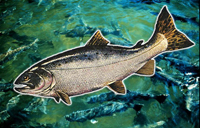NOAA’s Fisheries Service Issues Far-Reaching Plans for Protecting Northwest Salmon
May 5, 2008

Pacific Salmon.
(Credit: NOAA)
NOAA’s Fisheries Service, the federal agency charged with protecting Northwest salmon listed under the Endangered Species Act, released today a trio of biological opinions that provide comprehensive, far-reaching plans for the protected salmon species.
A biological opinion, a requirement of the ESA, sets forth benchmarks other federal agencies must meet to avoid undue harm to listed fish. All three of today’s biological opinions will be in effect for at least 10 years.
Two of the plans govern federal agencies’ operations of eight hydropower dams in the Columbia River basin and almost two dozen other Northwest dam-related irrigation projects on the Upper Snake River in Idaho. The third sets forth a plan for managing salmon harvests for Indian tribes in Washington, Idaho, and Oregon, and for those states themselves.
“These biological opinions not only meet the law’s requirement to protect fish, they also improve the prospects for recovery,” said Bob Lohn, head of NOAA’s Fisheries Service’s Northwest region, based in Seattle. “In these opinions, we’ve taken a close look at all of the major factors --- the hydro system, habitat, hatcheries, and harvest --- and are making sure that they’re all working toward heathy salmon runs. .”
Lohn praised the set of accords signed last week between the federal agencies that operate the dams and Northwest Indian tribes, and the new relationship that the accords represent.. ”This is exactly the kind of joint effort that we need to get on-the-ground projects going and long-term improvements underway.”
He said that the accords will continue the collaborative approach urged by a federal judge. The judge had rejected the agency’s earlier biological opinions for both hydropower operations and the irrigation projects.
Thirteen populations of salmon, including steelhead, are affected by some or all of the dams and are listed for protection under the ESA.
NOAA has made important changes to make the hydropower biological opinion more robust since its public release as a draft document last October.
- The new document includes a strengthened climate change section, which takes climate shifts and their likely effect on salmon into consideration.
- The new biological opinion factors in the effects of hydro operations on killer whales and green sturgeon to make sure that those important species are not adversely affected as steps are taken to protect salmon.
- The analysis supporting these opinions was based on the best available science and validated by several independent science reviews.
Throughout this biological opinion the agency’s approach has been to assure an extra measure of protection for salmon, especially when it comes to anticipating future conditions.
The National Oceanic and Atmospheric Administration, an agency of the U.S. Commerce Department, is dedicated to enhancing economic security and national safety through the prediction and research of weather and climate-related events and information service delivery for transportation, and by providing environmental stewardship of our nation's coastal and marine resources. Through the emerging Global Earth Observation System of Systems (GEOSS), NOAA is working with its federal partners, more than 70 countries and the European Commission to develop a global monitoring network that is as integrated as the planet it observes, predicts and protects.
